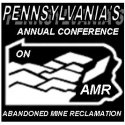EPCAMR’s Regional Reforestation Planting Project was recently selected for funding by the Appalachian Coal Country Team (ACCT). The project will be incorporated into the design and reclamation of the three-acre Huber Miner’s Memorial Park in Ashley, Pennsylvania, created by the Huber Breaker Preservation Society (HBPS). The HBPS was an integral partner in the application and will assist with the project through the assistance of volunteer members to monitor and provide research data on the planting of 40 trees. Half of these trees will be planted in a hole on the culm banks, while the other half will be planted inside Groasis Waterboxxes, provided by the ACCT. Funding for the trees and Waterboxxes provided is valued at $400.
The Groasis technology was developed and introduced by AquaPro Holland, a private company founded by inventor Pieter Hoff. It is a copy of how Mother Nature solves the problems of trees living in deserts, eroded areas, and upon rocks. EPCAMR believes this innovative idea will allow us to restore the abandoned culm banks within the park. The Groasis Waterboxx was developed in 2009 as an ‘intelligent water incubator’ that produces and captures water from the air through condensation and rain. The condensation is caused by artificial stimulation and the water is captured because of the design of the device, without the use of energy.
This collaborative research effort will involve the ACCT and the Western Hardrock Watershed Team (WHWT) regions in order to document the Waterboxx effect under different conditions. Both teams will work with local community organizations to train volunteers to monitor the project and gather relevant research data. The information will be analyzed and the viability/value of the Groasis Waterboxx will be determined. By participating in this research effort, EPCAMR and the HBPS will be part of restoring ecosystems and creating productive green spaces.
Currently, there is an assortment of trees on the site that can survive in the dry culm banks, including quaking aspen, black birch, white pine, and larch pine. This project has the potential to change the tree species capable of growing on the site and in turn could enhance the wildlife habitat of the park, while enhancing the natural beauty of the site. This project incorporates also adds a low-impact stormwater best management practice into the park. The Waterboxxes will also reduce stormwater runoff on the site by allowing a slow infiltration of rainwater into the culm bank soil. EPCAMR will coordinate with DCNR State Regional Forester, Nick Lylo, and ACCT Reforestation Coordinator, Alaina Asbury, as technical advisers on the project.
EPCAMR and HBPS will host environmental education activities at the site throughout the coming year to promote the park and educate elementary and high school students, regional photographers, and amateur historians and preservationists about the history of the Huber Breaker. EPCAMR will work with DCNR Environmental Education Specialist, Diane Madl, and Luzerne Conservation District Watershed Specialist, Aaron Stredny, to assist with outreach efforts.
EPCAMR and the HBPS will promote the research process until project completion. EPCAMR will provide the public with brochures and other materials on the Waterboxx technology and will include information on our the EPCAMR and HBPS websites and Facebook pages. EPCAMR will reach out to community partners to assist with planting the trees and recording their growth. EPCAMR already has contacts with the environmental service clubs from Luzerne County Community College, King’s College, and Wilkes University.
EPCAMR and the HBPS are required to report quarterly on the progress of the Groasis Waterboxxes installed on the site. These reports will be part of a final report to be submitted to the Office of Surface Mining and Groasis. The project will conclude one year after the initial tree planting.
Volunteer tree monitors will receive free training and assistance from the ACCT Reforestation Coordinator. This project requires the involvement of a local forester, who will analyze the data collected from the Waterboxxes. A monitoring checklist will be provided to be filled out by the volunteers at each site visit. The checklist must be closely followed to maintain the credibility of the collaborative ACCT/WHWT/Groasis research effort.













You must be logged in to post a comment.